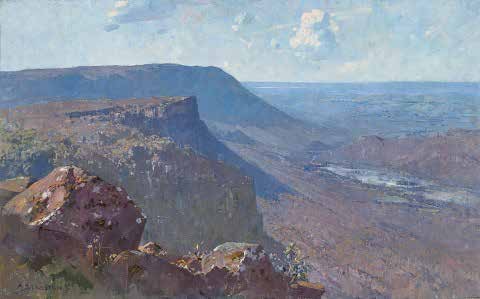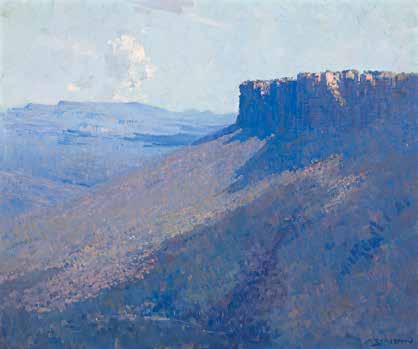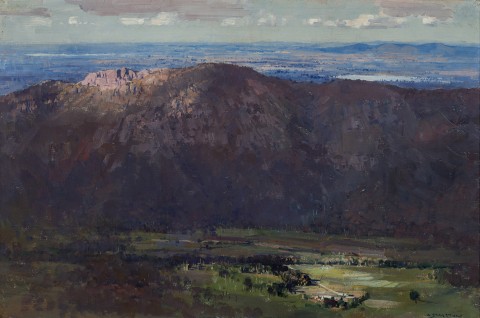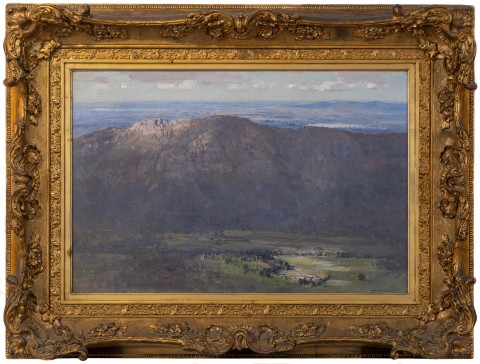BORONIA PEAK AND STAWELL, 1920
ARTHUR STREETON
oil on canvas
51.5 x 76.5 cm
signed lower right: A. STREETON
bears inscription on stretcher bar verso: Stawell from Boronia Peak / The Grampians / Victoria / 7
W. Schmidt, by 1935
Private collection, Melbourne, acquired via private auction, c.1936
Thence by descent
Private collection, Melbourne
Mr. Streeton’s Exhibition of Paintings of the Grampian Mountains, Athenaeum Hall, Melbourne, 1 – 6 November 1920, cat. 7 (as ‘Boronia Peak and Stawell’)
Colquhoun, A., ‘Arthur Streeton’s Art Pictures Exhibited’, The Herald, Melbourne, 1 November 1920, p. 8 (as ‘Boronia Peaks’)
Streeton, A., The Arthur Streeton Catalogue, Melbourne, 1935, cat. 743 (dated 1921, as ‘Boronia Peak’)
1 ST.jpg

Arthur Streeton and his family sailed from London in late 1919, arriving in Melbourne in February the following year. Renting a house in Murphy Street, South Yarra and a city studio in Bourke Street, he presented a solo exhibition at the Victorian Artists’ Society Galleries in March, before spending several months in Sydney. A second Melbourne exhibition in November featured new paintings – including Boronia Peak and Stawell, 1920 – which Streeton had made on recent painting trips to the Grampians and the Dandenong Ranges. Archibald Colquhoun announced it in the Herald, writing: ‘At the Athenaeum Hall, Collins street today, Mr Arthur Streeton opened with a private view of an exhibition of about 20 paintings, chiefly depicting the sunlit peaks and melting distances of the Grampians district and the picturesque country in the vicinity of Sherbrooke.’1 He went on to note that Streeton’s ‘subject matter, particularly in the Grampians pictures, is scenic, in a typically Australian way, and there is evidence throughout… of an artistic sincerity of purpose, and a close and unbiassed observation of the changing effects in nature.’2
Celebrated as one of Australia’s most distinguished painters, Streeton was renowned for his depictions of the Australian landscape, and by the mid-1920s, had established a reputation as ‘the pre-eminent creator of national images’.3 In the aftermath of the First World War in particular, the Australian pastoral landscape assumed new and potent meaning, symbolising a peaceful and prosperous future, as well as contributing to the expression of a burgeoning national identity. As Mary Eagle notes, Streeton’s first paintings in that genre were created around Heidelberg in the late 1880s,5 and the best known of them, Golden Summer, Eaglemont, 1889 (National Gallery of Australia) – rolling grassy plains, gum trees and grazing sheep, together underneath a brilliant blue sky – combines all of the elements that characterise his now iconic ‘blue and gold’ landscapes.
1 ST2.jpg

While most lauded Streeton and his art during these years, some were critical of what they perceived to be an overly commercial attitude which included regular, well-promoted exhibitions and a business-like approach to sales. Similarly, a skilful technique and great facility with his medium was seen by some as a mark of insincerity, the sign of an artist who was resting on his laurels rather than pushing into new creative territory. The balance of judgement ultimately fell in Streeton’s favour however, with contemporary works that reflected the skill honed over the course of a long and productive career continuing to be acquired during these decades for major public collections including the National Gallery of Victoria, the National Gallery of New South Wales and the Art Gallery of Western Australia. In 1931, he was honoured with a major retrospective at the National Gallery of New South Wales, and additional acknowledgement of his career and contribution came six years later in the form of a knighthood for services to art.
Boronia Peak and Stawell emerged from Streeton’s first visit to the Grampians – or Gariwerd to its traditional owners – in the Western District of Victoria. In the Spring of 1920 he stayed at Harry Armytage’s farm at Dunkeld, in the shadow of Mount Sturgeon, and was clearly captivated by the pictorial potential of the area, returning again the following winter. Visiting once again in 1926, he stayed further afield at Willaura, where he began the Land of the Golden Fleece paintings in which the dramatic form of the Grampians rises up in the background, framing the pastoral scene below. In this work, Streeton’s vantage point takes us high up into the mountains, looking across an expanse of flat, open ground to a majestic mountain range that fills the picture plane, and into the landscape beyond. His brushwork is confident and varied, fine lines defining the white trunks of the trees in the foreground and much broader strokes, only slightly variegated in colour, describing the rugged, facetted forms of the mountain. He skilfully uses light to guide us through the scene, from the buildings and road in the lower right seemingly spot-lit through a break in the clouds, to the rocky outcrop in the upper left of the scene and finally, the lake in the upper right which reflects the delicate blue of the springtime sky. Distinctively of its time and place, this painting reminds us why Lionel Lindsay, writing a decade later, enthusiastically and presciently claimed that ‘The importance of Arthur Streeton to Australian Art cannot be overstated. He is great, as Melba was great, a product of the soil and sun of this wide land. In fifty years’ time… every art institution in this country will have its Streeton gallery when a greater recognition of his genius has been pronounced by time.’5
1. Colquhoun, A., ‘Arthur Streeton’s Art’, The Herald, Melbourne, 1 November 1920, p. 8
2. Ibid.
3. Eagle, M., The Oil Paintings of Arthur Streeton in the NGA, National Gallery of Australia, Canberra, 1994, p. 161
4. Ibid.
5. Lindsay, L., ‘Streeton’s loan exhibition’, Art in Australia, third series, no. 42, 15 February 1932, p. 9
KIRSTY GRANT

